Foothill Flyers Race Reviews
Last update Feb. 14, 2018
Kilimanjaro Marathon, Half and 5K
Last Sunday in February, Tanzania Africa,
Application & info: Click on above or call kathy Loper Events at (619) 298-7400, email: kathy@kathyloperevents.com
Latest 2008 itinerary
An African adventure trip with a Marathon, half or 5K thrown in at the foot of Mt. Kilimanjaro. Wild game safari's, sight seeing and optional 6 day trek to the top of Mt. Kilimanjaro or Hot Air Balloon Safari.

A Journey in Africa
The Trip of a Lifetime
By Nancy Gilmore
Part 1
Jambo! Even though I've been back for five months from my trip to Africa to do the Kilimanjaro marathon and trek up the mountain, I still get questions. Several people have said, "When are you going to tell the story in the Flyers Newsletter?" I will try to be complete, while also being brief. My trip was different from Bill Dickey's and Robbie Robinson's. I went on the safari trip that included luxurious accommodations in great lodges for two weeks with only one week of camping that was during the hike to the top of Mt. Kilimanjaro. They, Robbie and Bill, both spent almost the whole three weeks camping.
We all left in February for Africa to spend two weeks on safari and one week climbing Kilimanjaro. We flew to Detroit, then to Amsterdam, and then on to Kilimanjaro - a whole day of flying around the world. At Kilimanjaro we stayed one night catching another flight to the Serengeti. The views from the small plane were spectacular! I got some great pictures from the plane of the volcano craters, especially the Ngorongoro Crater, to which we would return by land.
The 2nd day in Africa we started out for the Serengeti National Park Animal Preserve and our first guided game "hunt." These "hunts" are from a pop-top van that accommodates six people. The only shooting we do on these hunts are with our cameras. Each van has one guide to help spot the game. The guides are great, they know exactly what they're looking for out on the Serengeti. They can spot the game very quickly and then direct our attention to the area. We've all got our binoculars and cameras at the ready. We are not allowed to leave the vans except at designated rest areas.
We learned some words in Swahili: Jambo (Hello!), Caribou (pronounced ca-ree-boo) (welcome/you're welcome), See Mama (stop), Zawa, Zawa (go), Sante/A Sante (thanks), Hakuna Matata (No worry, everything O.K.), Pole, Pole (slowly, slowly).
We saw the famous "Sausage Tree" that has huge sausage-like fruit hanging from its limbs. There are many acacia trees that spread out, especially the Flat -Top Acacia, and these provide shade for the lions that relax under them during the day. The Whistling Thorn tree is a favorite of giraffes as they have split tongues so that they can eat the leaves between the thorns. The Candelabra Euphorbia looks like a giant candelabra made of cactus like branches.
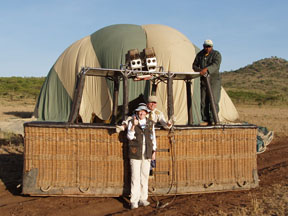
While in the Serengeti, I go on my first hot air balloon ride. The Balloon Safari is a one hour flight out over the Serengeti Preserve. It is great fun, even though we don't see any different animals. We are able to have a great view of the landscape from above. Our balloon "driver" was able to put the balloon down on the "X" marked spot without a hitch. We have a champagne brunch to celebrate our safe landing.
We left the Serengeti to go to the Ngorongoro Crater, which is large volcanic caldera that is now home to a huge variety of game and birds. Again we go out for "game hunts." We are looking especially for the "Big 5": rhinos, leopards, lions, buffalo, and elephants. Rhinos are the most difficult to find as there are very few, maybe only eight in the whole park. Our guide spots one in the far distance - I have to take his word for it, my binoculars aren't strong enough to verify the sighting. We did see leopards going across the plains with their captured prey in their jaws.
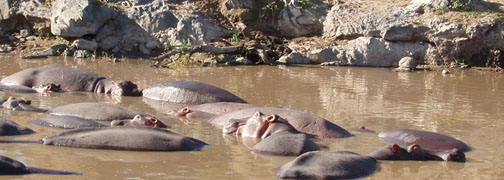
It is in the crater that we see the results of a lion kill of two buffalo. There are several lions guarding their prize. Also, several vans have come in to see the sight. Bill's van was on the spot when the actual take down was made. Our van came in after both buffalo were down. The lions weren't intimidated by our presence at all. They even took shelter up against a couple of the vans to get out of the bright sun. Since these lions were lounging right up against the vans, the vans had to stay put for fear of injuring the lions if they moved. At this time there must have been at least eight vans watching the "show". Actually, not much was happening, the action was over and the lions were just guarding their "kill" while we watched them lie around and rest. Our guide told us that they would be doing that most of the day and would come back during the evening to eat.
We also went to a Masai village and visited with the villagers. One, Sin Ja, was kind enough to invite us into his house to tell us about his life and his home. We also saw the new school, for kindergartners. Most of the tribesmen make handicrafts to sell to tourists. We bought our fair share. All of those who are able to go on to school in Arusha or Moshe reap the benefits by being spokesmen for their tribes, and are also able to go on to other jobs which help them to be financially solvent.
Running the Kilimanjaro Half Marathon
By Nancy Gilmore
Part 2 - February 26, 2006 - Moshi, Tanzania
The day before the race we were able to visit the stadium, check out our route from the Keys Hotel to the start, and get an idea of how the marathon would start and finish. This was very helpful since we didn't know anything about the city or the event. We were given some information about what to expect at the start and finish. We know that the race will go out towards Kilimanjaro and those running the half marathon will do a turn around and run back along the same course. The race will start at 7:00 a.m. This is very good as it is warm and will continue to be hot throughout the race. We all gather at the starting line before the race for pictures and good wishes. Many of our group will do the marathon - even those who will trek up Kilimanjaro after only one day of rest.
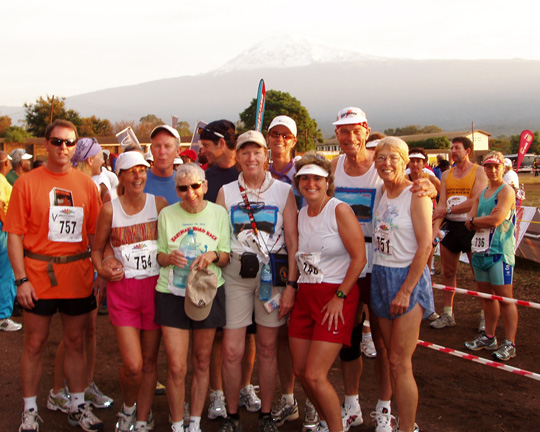
The race route itself goes out towards the foot of Kilimanjaro. We can see 'Kili' almost all the way to the point where we must turn around and head back to the stadium. Since I am race walking, I get many calls of 'polee, polee' which is Swahili for 'slowly, slowly.' Also, there are those who are laughing at my gait as I walk along. I pass many Africans walking also. They are very friendly. One woman and I keep pace for many miles. I eventually pull away from her, but I see her at the end and we congratulate each other on our successful finish. She says next year she will do it faster and be able to run more of the race. I also get into a conversation with some men who are walking along. They are trying to keep up with me. They keep saying I'm too fast and want me to slow down. We have much fun as we enter and leave aide stations or come to small uphill sections. So even though I'm not with any of the group from the U.S., I'm not alone. Many spectators along the way also call out to me as I pass.
There are many people out on the street and the sidewalk as the morning progresses. Many are dressed for church. The women are usually in colorful dresses, skirts and blouses, and are wearing bright hats. Men and boys are usually in dark pants and white shirts. They look very neat in their Sunday best attire. Many wave at us and the shouts of 'Polee, Polee' are always heard. At the end, those of us from the U.S. wonder if they're making a comment about how slow we are, as the Africans are way out in front, or telling us to go slow due to the weather.
Since there are always concerns about water purity in countries like this, we are glad to know that bottle water will be used. The aide stations have a lot of water and it is really welcome. The volunteers are excited about helping us and want to make sure we are taken care of. Bathrooms are another story. I didn't need to find one, but others said they had trouble finding relief.
We also run past little villages and fields of coffee crops. We get a nice look at the countryside as we run along. One of the most interesting sights is those who catch a 'bus.' Most of the buses are actually vans. The idea is to pile as many people into the van as possible. You also have to jump on the 'bus.' It doesn't necessarily come to a complete stop for riders to jump on or off. If there is someone who is completely inside the bus, then a full stop is made. But if the rider is on the side, the stop is only a few seconds. Since we are running along the road, these pick-ups can be very hazardous. As I'm walking, it's not a problem for me. I have time to adjust as I walk along. Some runners said they were a little taken aback by these sudden stops right in front of them without warning. There are also cars, trucks, and bicyclists going along the roads beside us. We forget we are in Africa and can't expect all the safe routes that are prepared and covered by police and volunteers in the U.S.
When I get to the finish line, I can see the many people inside the arena. It is not easy to see what is going on and to connect with people. Unlike marathons in the U.S. there are no free refreshments. Vendors are selling refreshments.
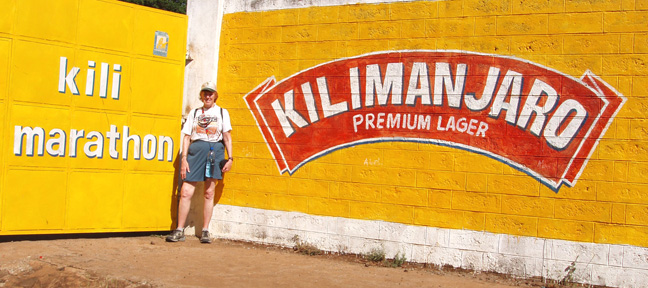
Even the beer sponsor does not give out free beer. One of the groups we know will be there is the Hash House Harriers running club. Unfortunately, by the time I finish, they are out of beer. They are packing up to head out. I find other members of our tour group and we pool our resources to get some refreshments. The award ceremonies are in full swing. Most of the winners are Africans, and are very fast. One of our group was out to run the marathon to get placed in the Guinness book of World Records. She was vying for the youngest woman to run a marathon on every continent. It doesn't matter what her time is, only that she completes the entire course. I am there when she completes her marathon. She doesn't win any other prize, but another woman in our group does. That gal takes 2nd place in her age division. Only Africans, however, are eligible to win the monetary awards. As we wait for others to come in, we cheer and celebrate all the runners and the entertainers. One of our group is running his very first marathon and when he finishes he has 3-4 boys at his side. They have been running barefoot for the last 2-3 miles with him. Luckily, I get a shot of his finish. He is thrilled that he will have picture of the moment. We all get medals to indicate our finish of the marathon or 1/2 marathon distance.
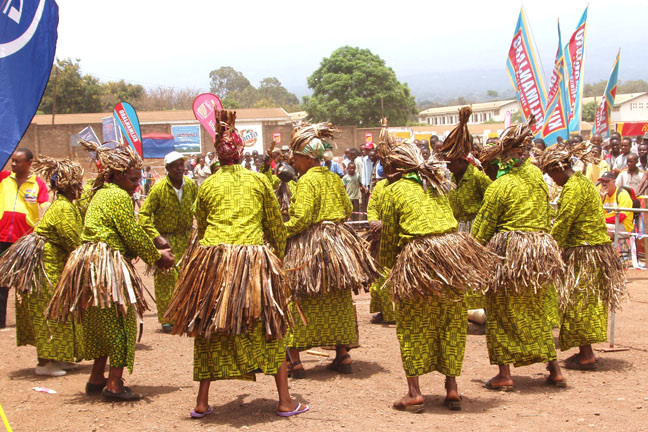
After the marathon festivities, I head back to the hotel. Another of our group and I are walking along when a guy starts talking to us. He says he wants to interview us for the newspaper and radio station of the university where he attends school. He asks us several questions about our journey, our experiences in Africa, our running experience, our plans, and our thoughts on our trip. He then offers us a trip back to our hotel as a thank you for answering his questions - he has his own car, not very many Africans do. When we get back to the hotel we offer to pay him for the ride, but he says definitely not, he owes us. Later we find out he's not just a news reporter for the university newspaper and radio station, he's a prince of the local tribe and quite well known.
All in all our Kilimanjaro Marathon / Half Marathon experience was quite memorable.
Climbing the Mountain
By Nancy Gilmore
Part 3
Here is a day-by-day record of our experience. Luckily, I took time to write a little bit each day of my journey. Hope this keeps you interested to the end - even though you know the end.
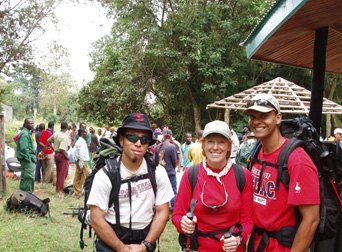
On February 28th we started our trek up Mt. Kilimanjaro. There were about 30 of us in the group. We got off to a late start. The climbers were ready, but for some reason our guides and porters were late. We started with the weighing of our bags at the hotel in the morning. There was a weight limit of 50 lbs. I don't think anyone was over the limit. But it was tight because our bags had to include most all of our personal gear: boots, running shoes, sandals, sleeping bag with extra mats, pillow and inner blanket, medicines, all clothing for a week, toiletries, snacks. I elected to wear my heaviest boots to make sure I made the weight limit. We had to carry a backpack with our daily needs: jacket, hiking poles, rain gear, light snacks, water (at least 2 liters/day), camera, and any other personal items of our choice.
We had about an hour ride from our hotel to the actual start of the trek. The trail starts at an elevation of approximately 4,000-ft. This first day we hike to 10,000 ft. We had some rain midway through the day which muddied things up and made our going very slippery. Luckily, I had the proper clothing and kept dry throughout. One of our climbers and fellow Foothill Flyer, Robbie Robinson, took a fall and hurt his arm. He had to go on though, as this route is not considered a downward route (and it is much more difficult going down). Many of our group helped him by carrying his backpack the rest of the way. We had 2 doctors in our group and they ministered to him. It didn't look like his arm was broken, but when he returned home, he found out it was broken and had to have surgery to get it properly aligned. He went all the way to the top with his broken arm in bandages. He had to have a porter carry his backpack the rest of the way up the Mt.
First Day: By the time we got to camp the first day it was dark, muddy, and still raining. I decided to stay in my tent rather than deal with the mud. I had the rest of my lunch, energy bars, and trail mix to eat. It was warm and cozy in the tent and I was not up to fighting the mud anymore. Also, when we got our bags, they were drenched. Mine was full of water. It was as if it had floated down a stream. Luckily, I had used inner plastic bags for packaging and only my sleeping bag and mat were wet around the edges. I could sleep comfortably in the dry areas. One of our gals, Carmel, was not so lucky. She had joined us late, in Moshe, and had not got the word to put her things in plastic inside her bag. Her sleeping bag was drenched. Luckily, her tent-mate had some dry liner that she was able to use. But she had to sleep fully dressed. That night one of our fellow campers slid almost completely out of his tent due to the rain and mud. The tents were placed on the hillsides. It was hard to decide where to set up your sleeping bag as it depended on which way on the hill your head would be.
The 2nd day was more challenging than the 1st. We had more rain, but this day it was a cold rain. Again I was lucky to have my excellent clothing to keep me dry and comfortable. Our other trekkers are very supportive. When assistance is there, our mates are there to help. Robbie moves well through the day and does not appear to be suffering much from his 'sprained arm'. We move steadily up the mountain and I feel that I'm able to keep up to the pace the guide is setting. We have been divided into groups according to the pace we are able to maintain. There are generally 3 groups. No one is suppose to go ahead of the guide. This is for their own safety. What happened to Robbie reinforces the idea that we should stay with our guide and fellow trekkers. This day we make it to our camp at 13,000 ft. by 4:00 p.m. and have daylight to get settled in. But it is definitely colder today. My dry, warm gear is very welcome. Luckily, our bags have been put inside tents and are dry when we arrive. We all had dinner in the 'mess' tent and enjoyed a welcomed hot meal with soup, bread, vegetable, and meat. We had fun sharing our day's experiences.
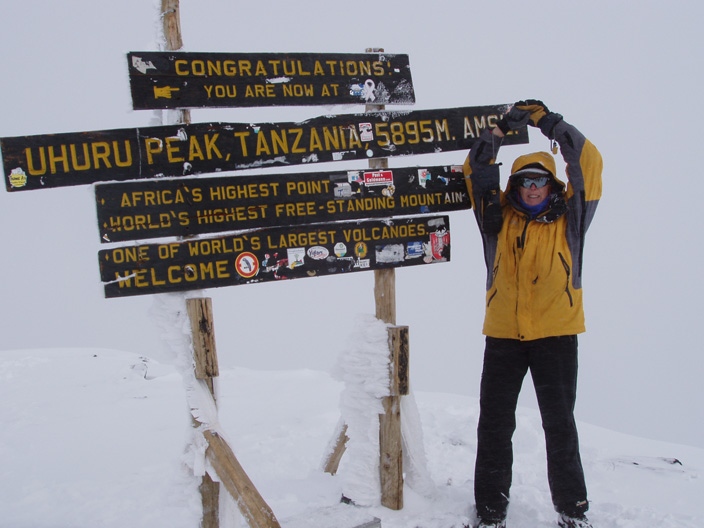
On the 3rd day we will go only a short distance, this is to give our bodies time to acclimate to the elevation of 13,000-13,500 ft. Robbie's arm is very swollen and red; it does not look good. Two of our group must go down, as they are not handling the climb well. We must go up and down through many levels today. It is a very rocky terrain. They split us into our 3 groups: the first group is those of us who are able to move steadily up the mountain; the 2nd group must go slower and take some rest stops; and the 3rd group must go even more slowly still. I am in the first group composed of nine or so people, 3 of us are women. On this day I took a fall. It could have been very serious. Luckily, when I started to fall I twisted around so that I landed on my backpack to cushion my fall as I landed on very jagged rocks. Also, I screamed out and that alerted the guide in front of me who turned around just in time to catch my head so that it didn't hit a very rugged rock below. One of my trekking poles broke in half near the neck of the shaft due to the weight of my body landing on it. Luckily, nothing else was damaged. One of our fellow hikers, Joshua, gave me one of his poles to make it the rest of the way up the mountain. He and Foothill Flyer Vinnie Torres, came quickly to my side after I took the fall. As I look up from where I landed I see the faces of our other hikers looking down at me in shock and their mouths wide open. But Vinnie and Joshua jumped so quickly they were on both sides of me ready to help in any way I needed it. Luckily, I had no body damage. I got up and continued on with no problems the rest of the way. During the night, we had lots more rain and wind. It was during this time that I again wondered: Why did I decide to do this? Was I going to be able to go on to the top? What would be in store on the next day? But I am so exhausted, I have no energy to worry and I'm able to sleep comfortably through the night.
Day 4 we hiked again just a short distance and on up to 14,500 ft. This gives our bodies more time to acclimate. We camp on a plateau. It starts to hail and snow around 2:00 in the afternoon becoming cold and we must put on our warm gear. For me that means 2 pair of socks, 2 pair of pants, 2 pair of gloves, and my warm jacket with the head warmer that Mary Ann O'Hara loaned me. Although our group took its time getting to this level, our guide tells us we made it in better time than expected. There are many behind us that are in our party, but some of them don't get to this level for 3 more hours. All arrive before dark though. We will stay at this level till around midnight, when we start our final trek to the top of the mountain. There are two who are having more problems with the elevation and will not be able to go on. They wait here till we return from our trek to the top.
For our final trek we rest after arriving at this level and will be dressed and ready for the final assent at about 11:00 p.m. We will continue in our sub-groups. So that we can all get to the top together, the slowest group, with our injured hiker, Robbie, starts first at 11:30. Then the next group starts at 12:00 midnight. And another small group leaves at 12:15 a.m. I am in the 'fastest' group of about 14 and we start at 12:30 a.m. We hope to all get to the top for sunrise. It is hailing and snowing. The trek up is in 2-3 ft of snow all the way. Luckily, all I have to do is put my feet in the steps of those ahead of me. I am able to make it without too much difficulty. We are going very slowly: Polee, Polee (Swahili for slowly, slowly) the guide tells us. Our group passes several other groups on our way to the top. We also pass all of the sub-groups in our party on our way up. One group passes us going down, saying they have had it and can't go any further. As we press on 3 of our members leave us to join the slower groups. Now there are 9 guys and 2 women going on ahead of the others. We didn't make it to Stella Pt., a point with good views about 500 ft. below the peak, by sunrise, but it was snowing and hailing so much, there wasn't much to see from the top anyway. We stopped at Stella Pt. for about 10 min. and a snack. Then it's on to Uhuru Peak and jubilation. .
I feel great since I'm the oldest woman in the group and the other is half my age. Along the way to the peak we get great views of the glacier, but due to the conditions we didn't stop for pictures, a mistake as the snow and clouds completely engulf it as the weather gets worse and we can't see the glacier coming back. We again see all the members of our large party still heading up the mountain. I suggest to Robbie that he go back, as the conditions are severe now, but he continues on to the summit. It ends up taking him 22 hours that day going up and back down to the next camp. Our group made it to the top in 7 hours, while most others in our party took 9-11 hours.
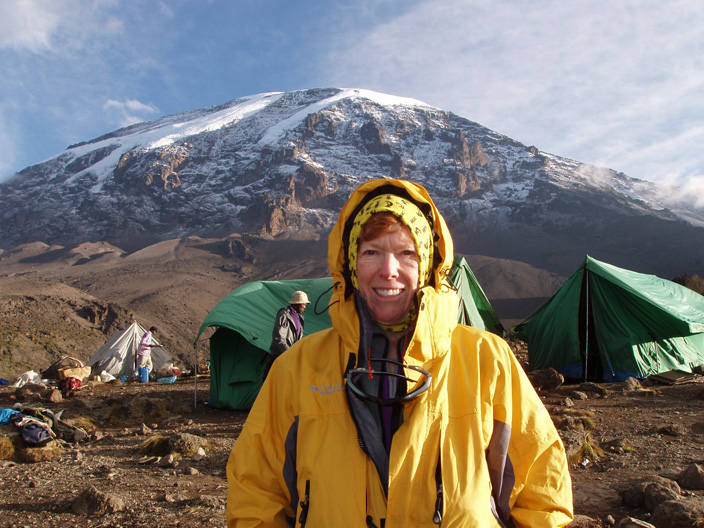
Going down the mountain is almost as difficult for me as it was going up. My knee that is without cartilage is feeling the downhill pressure. Luckly, I brought a knee brace to use just for this purpose. We are slipping and sliding all over the place in the snow and scree (volcanic debris). Vinnie got hit with problems to his equilibrium and our guide rushes him down to a lower level. That appears to help him as he goes down 2-3,000 ft. very quickly, but it takes 2-3 hours for his body to return to normal. We are all feeling very tired as most of us did not sleep since the previous morning. We have been up 24 hours. Our bodies are weary and due to the exhausting physical experience that we have put them through, they are not responding as we would expect. We still must navigate through rocks and other hazardous terrain as we decend the mountain. We are lucky though, though: we will have 4 hours to rest and have lunch before we head on to the next camp. Those who are still on the mountain, will have much less time before they must make the trek to the next camp, Millenium Camp, at about 4:00 p.m. Later I find out that not all made it to the peak. A few had to stop at Stella Pt. - about 500 feet from the summit.
Hiking to the next camp has a gradual downhill after the initial decent from the peak. It takes me about 2 hours - I'm last in our sub-group this time as my 'good' leg has started to hurt from an old injury from 1994 when I had broken it in 2 places. It's probably due to the many hours of downhill pressure. One of our fellow hikers helped me out by carrying my backpack for at least a mile. This really took the pressure off my sore legs. I'm totally exhausted and the only one of our whole party has made it to the camp. I weigh my needs - food or sleep. I decide on sleep. I'm in bed by 7:00 p.m. I've been up since 7:00 a.m. the previous day - 18 hrs. I hear the next morning that Robbie got in about 2 hrs. later. He has been out on the mountain the whole time, probably close to 22 hours. The next morning I hear that only 10 people decide on dinner over sleep, everyone else calls it a day and heads for the hay. We all agree - it is the most exhausting thing we have ever done.
Day 6 is an all downhill trek. We will go from 13,500 - 14,000 feet down to the 4,000 foot level to get on a bus for town. Most of the going is a sharp down hill. The trail is very well maintained and we will spend a lot of time in rainforest-like conditions. It's not raining and the weather is good going down. Finally, something is going in our favor. My leg continues to give me trouble, but short rests and massage helps. Luckily, I also have my trekking poles. There are no lunch stops on this day. We do stop at the check-out station where we sign off the mountain. We have time to chat, munch on our snacks, and use the bathroom facilities. We can make as many rest stops as we want. The total time out on trail ranges from 6-8 hours.We get to our hotel and it's great to have a warm shower - the first in 6 1/2 days. Later there is a celebration with toasts and congratulations all around. Those of us who made it to the top receive certificates.
Post Script: I would not advise anyone to do this if they have any medical problems. No one should rely on having EMT type trained assistance, doctors, or ambulances. The porters and guides are like rangers in our national forests, they are not necessarily trained in first aid and it did not appear that they were carrying any first aide equipment in their packs. Assistance had to be sent for. Also, there aren't cell phones to make emergency calls - isn't it like that when we go off to the back country?
This activity is definitely only intended for the fit. The year before, the group that had done this same route had very good weather conditions - no rain at the lower level nor hail or snow going up the last section. So, preparation for all weather conditions is very important. Also: train, train, train. I was able to make 4 hikes in the San Bernardino Mts. during the winter with snow on the ground and temperatures between 30 & 40 degrees. I carried my pack, wore the clothing I expected to wear, and used the equipment I would use on the hike. I think it made the difference. I had no illness and all gear worked out well. I also took Diamox as recommended to help my breathing adjust to the altitude. It was an exhilarating experience. There must be another mountain I can climb!